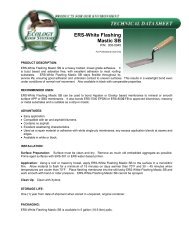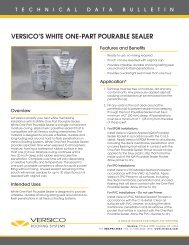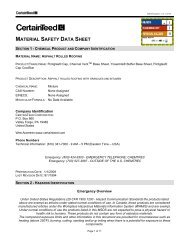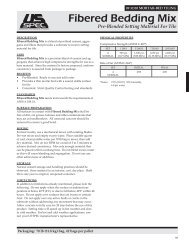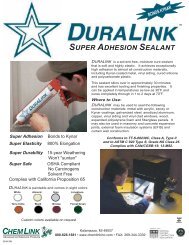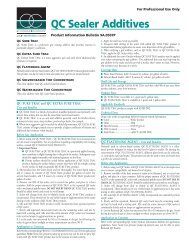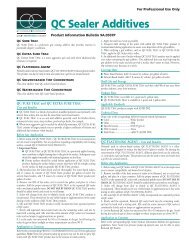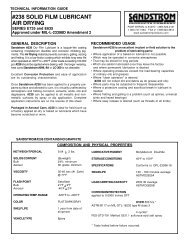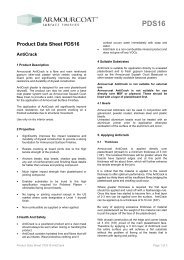Simpson Anchors - Anchoring and Fastening Systems - BuildSite.com
Simpson Anchors - Anchoring and Fastening Systems - BuildSite.com
Simpson Anchors - Anchoring and Fastening Systems - BuildSite.com
Create successful ePaper yourself
Turn your PDF publications into a flip-book with our unique Google optimized e-Paper software.
16<br />
UNDERSTANDING THE ISSUES<br />
Metal anchors <strong>and</strong> fasteners will corrode <strong>and</strong> may lose load-carrying<br />
capacity when installed in corrosive environments or exposed to corrosive<br />
materials. There are many environments <strong>and</strong> materials which may cause<br />
corrosion including ocean salt air, fi re-retardants, fumes, fertilizers,<br />
preservative-treated wood, dissimilar metals, <strong>and</strong> other corrosive elements.<br />
The many variables present in a single building environment make it<br />
impossible to accurately predict if, or when, signifi cant corrosion will<br />
begin or reach a critical level. This relative uncertainty makes it crucial that<br />
specifi ers <strong>and</strong> users be knowledgeable of the potential risks <strong>and</strong> select a<br />
product coating or metal suitable for the intended use. It is also important<br />
that regular maintenance <strong>and</strong> periodic inspections are performed, especially<br />
for outdoor applications.<br />
It is <strong>com</strong>mon to see some corrosion on anchors <strong>and</strong> fasteners especially<br />
in outdoor applications. Even stainless steel can corrode. The presence<br />
of some corrosion does not mean that load capacity has necessarily been<br />
affected or that a failure will occur. If signifi cant corrosion is apparent or<br />
suspected, then the wood, anchors <strong>and</strong> fasteners should be inspected by a<br />
professional engineer or general contractor <strong>and</strong> may need to be replaced.<br />
In the last several years, preservative-treated wood formulations have<br />
changed signifi cantly. Many of the new formulations are more corrosive to<br />
steel anchors <strong>and</strong> fasteners than the traditionally used formulation of CCA-C.<br />
<strong>Simpson</strong> Strong-Tie testing has shown that ACQ-C, ACQ-D (Carbonate), CBA-<br />
A <strong>and</strong> CA-B treated woods are approximately 2 times more corrosive than<br />
CCA-C, while SBX-DOT (Sodium Borate) treated woods were shown to be<br />
less corrosive than CCA-C. (See technical bulletin T-PTWOOD for details).<br />
GENERAL SIMPSON STRONG-TIE RECOMMENDATIONS<br />
• Outdoor environments are generally more corrosive to steel. If you choose<br />
to use MG or HDG on an outdoor project (i.e. deck, patio cover), you<br />
should periodically inspect your anchors <strong>and</strong> fasteners or have a professional<br />
inspection performed. Regular maintenance including water-proofing<br />
of the wood used in your outdoor project is also a good practice.<br />
• For wood with actual retention levels greater than 0.40 pcf for ACQ<br />
<strong>and</strong> MCQ, 0.41 pcf for CBA-A, or 0.21 pcf for CA-B (ground contact),<br />
stainless-steel anchors <strong>and</strong> fasteners are re<strong>com</strong>mended. Verify actual<br />
retention level with the wood treater.<br />
1<br />
2<br />
3<br />
4<br />
CORROSION INFORMATION<br />
GUIDELINES FOR SELECTING THE PROPER ANCHOR OR FASTENER<br />
Evaluate the Application.<br />
Consider the type of structure <strong>and</strong> how it will be used. These re<strong>com</strong>mendations<br />
may not apply to non-structural applications such as fences.<br />
Evaluate the Environment.<br />
Testing <strong>and</strong> experience indicate that indoor dry environments are less corrosive<br />
than outdoor environments. Determining the type of environment where an<br />
anchor or fastener will be used is an important factor in selecting the most<br />
appropriate material <strong>and</strong> fi nish for use on the anchors <strong>and</strong> fasteners. To help in<br />
your decision making, consider the following general exposure information:<br />
Interior Dry Use: Includes wall <strong>and</strong> ceiling cavities, <strong>and</strong> raised fl oor<br />
applications of enclosed buildings that have been designed to ensure that<br />
condensation <strong>and</strong> other sources of moisture do not develop.<br />
Exterior - Dry: Includes outdoor installations in low-rainfall environments<br />
<strong>and</strong> no regular exposure to moisture.<br />
Exterior - Wet: Includes outdoor installations in higher moisture <strong>and</strong> rainfall<br />
environments.<br />
Higher Exposure Use: Includes exposure to ocean-salt air, large bodies of<br />
water, fumes, fertilizers, soil, some preservative-treated woods, industrial<br />
zones, acid rain, <strong>and</strong> other corrosive elements.<br />
Evaluate <strong>and</strong> select a suitable preservative-treated wood for<br />
the intended application <strong>and</strong> environment.<br />
The treated- wood supplier should provide all the information needed<br />
regarding the wood being used. This information should include: the specifi c<br />
type of wood treatment used, if ammonia was used in the treatment, <strong>and</strong> the<br />
chemical retention level. If the needed information is not provided then<br />
<strong>Simpson</strong> Strong-Tie would re<strong>com</strong>mend the use of stainless-steel anchors <strong>and</strong><br />
fasteners. You should also ask the treated-wood supplier for an anchor or<br />
fastener coating or material re<strong>com</strong>mendation.<br />
Use the chart on the right, which was created based on <strong>Simpson</strong><br />
Strong-Tie testing <strong>and</strong> experience to select the anchor or fastener<br />
fi nish or material.<br />
If a preservative-treated wood product is not identifi ed on the chart, <strong>Simpson</strong><br />
Strong-Tie has not evaluated test results regarding such product <strong>and</strong> therefore<br />
cannot make any re<strong>com</strong>mendation other than the use of stainless steel<br />
with that product. Manufacturers may independently provide test results or<br />
other product use information; <strong>Simpson</strong> Strong-Tie expresses no opinion<br />
regarding any such information.<br />
Due to the many different preservative-treatment formulations, fl uctuating<br />
retention levels, moisture content, <strong>and</strong> because the formulations may vary<br />
regionally, or change without warning, underst<strong>and</strong>ing which anchors <strong>and</strong><br />
fasteners to use with these materials has be<strong>com</strong>e a <strong>com</strong>plex task. We have<br />
attempted to provide basic knowledge on the subject here, but it is important<br />
to fully educate yourself by reviewing our technical bulletins on the topic, <strong>and</strong><br />
also by viewing information <strong>and</strong> literature provided by others. Additionally,<br />
because the issue is evolving, it is important to get the very latest anchor<br />
<strong>and</strong> fastener information on the topic by visiting our website at<br />
www.simpsonanchors.<strong>com</strong>/corrosioninfo.<br />
Stainless steel is always the most effective solution to corrosion risk.<br />
However, it is also more expensive <strong>and</strong> sometimes more diffi cult to obtain.<br />
To best serve our customers, <strong>Simpson</strong> Strong-Tie is evaluating the options to<br />
identify the safest <strong>and</strong> most cost-effective solutions. Based on our testing <strong>and</strong><br />
experience there are some specifi c applications that are appropriate for hotdip<br />
galvanized (HDG), mechanically galvanized (MG) or electroplated anchors<br />
(see chart below).<br />
Because increased corrosion from some newer preservative-treated wood<br />
is a new issue with little historical data, we have to base our re<strong>com</strong>mendations<br />
on the testing <strong>and</strong> experience we have to date. It is possible that as we<br />
learn more, our re<strong>com</strong>mendations may change, but these re<strong>com</strong>mendations<br />
are based on the best information we have at this time.<br />
See www.simpsonanchors.<strong>com</strong>/corrosioninfo for additional<br />
critical information.<br />
• Testing indicates wood installed dry reduces potential corrosion. If dry<br />
wood is used, see our website for additional information.<br />
Due to the many variables involved, <strong>Simpson</strong> Strong-Tie cannot provide<br />
estimates on service life of anchors or fasteners. We suggest that all users<br />
<strong>and</strong> specifi ers also obtain re<strong>com</strong>mendations for HDG, MG, or other coatings<br />
from the treated-wood supplier for the type of wood used. However, as long<br />
as <strong>Simpson</strong> Strong-Tie re<strong>com</strong>mendations are followed, <strong>Simpson</strong> Strong-Tie<br />
st<strong>and</strong>s behind its product performance <strong>and</strong> the st<strong>and</strong>ard limited warranty<br />
(page 10) applies.<br />
Low = Use <strong>Simpson</strong> Strong-Tie ® zinc plated anchors or fasteners as<br />
a minimum.<br />
Med = Use MG (ASTM B695, Class 55), HDG or Type 410 stainless steel<br />
as a minimum.<br />
High = Use Type 304 or 316 stainless steel anchors <strong>and</strong> fasteners as<br />
a minimum.<br />
Environment<br />
Interior Dry Low Low Low Med Med High High High<br />
Exterior - Dry 5<br />
Exterior - Wet 5<br />
Higher Exposure 5<br />
Uncertain 5<br />
Anchor <strong>and</strong> Fastener Minimum Coating Re<strong>com</strong>mendation - Structural Applications<br />
Untreated<br />
Wood<br />
SBX/DOT<br />
& Zinc<br />
Borate<br />
MCQ<br />
No<br />
Ammonia<br />
Med N/A Med Med High High High High<br />
2<br />
Med Med 3,4<br />
Med 3,4<br />
N/A 2<br />
High High High High<br />
High N/A High High High High High High<br />
2<br />
High N/A High High<br />
2<br />
ACQ-C, ACQ-D (Carbonate),<br />
CA-B & CBA-A<br />
With<br />
Ammonia<br />
Higher<br />
Chemical<br />
Content 1<br />
ACZA<br />
Other<br />
or<br />
Uncertain<br />
High High High High<br />
1. Woods with actual retention levels greater than 0.40 pcf for ACQ <strong>and</strong> MCQ, 0.41 pcf<br />
for CBA-A, or 0.21 pcf for CA-B (Ground Contact level).<br />
2. Borate treated woods are not appropriate for outdoor use.<br />
3. Test results indicate that MG/HDG will perform adequately, subject to regular<br />
maintenance <strong>and</strong> periodic inspection. However, the test method used is an<br />
accelerated test, so data over an extended period of time is not available.<br />
If uncertain, use 304 or 316 stainless steel.<br />
4. Some treated wood may have excess surface chemicals making it potentially<br />
more corrosive. If you suspect this or are uncertain, use 304 or 316 stainless steel.<br />
5. Mechanically-galvanized Titen HD ® anchors are only re<strong>com</strong>mended for temporary<br />
exterior applications.<br />
5 Compare the treated wood supplier's re<strong>com</strong>mendation with<br />
the <strong>Simpson</strong> Strong-Tie re<strong>com</strong>mendation.<br />
If these re<strong>com</strong>mendations are different, <strong>Simpson</strong> Strong-Tie re<strong>com</strong>mends<br />
that the most conservative re<strong>com</strong>mendation be followed.<br />
C-SAS-2009 © 2009 SIMPSON STRONG-TIE COMPANY INC.



